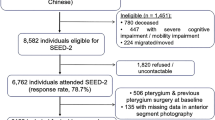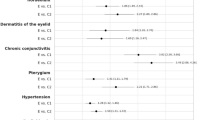Abstract
Purpose
To determine the prevalence of pinguecula and pterygium and to investigate their associations in a general adult population in North-Western Spain.
Methods
An age-stratified random sample of 1155 subjects ≥40 years was selected in O Salnés (Spain). From 937 eligible subjects, 619 (66.1%) participated (mean age (SD): 63.4 (14.5) years, range: 40–96 years, 37.0% males). An interview to collect history of systemic diseases and lifestyle details and a comprehensive ophthalmic evaluation in which pinguecula and pterygium were recorded was carried out. The prevalence of pinguecula and pterygium and their relationship with lifestyle factors and ocular and systemic diseases was investigated.
Results
The prevalence of pinguecula was 47.9% (95% confidence interval (CI): 43.9–51.9). This prevalence increased significantly with aging (P=0.002) and was higher in men (56.4%; 95% CI: 50.0–62.7) than in women (42.7%; 95% CI: 37.8–47.8) (P=0.001). The prevalence of pterygium was 5.9% (95% CI: 4.3–7.9). This prevalence also increased significantly with aging (P=0.005) and was 4.8% (95% CI: 2.6–8.4) in men and 6.5% (95% CI: 4.5–9.3) in women (P=0.346). After controlling for age and sex, pinguecula was associated with alcohol intake (adjusted odds ratio (ORa): 3.08; 95% CI: 1.60–5.95), pterygium with fluorescein staining (ORa: 2.64; 95% CI: 1.08–6.46) and both disorders with outer activity (ORa: 2.07; 95% CI: 1.36–3.15 and 2.28; 95% CI: 1.04–4.98, respectively).
Conclusions
Pinguecula is far more common than pterygium. Alcohol consumption is strongly associated with pinguecula. Fluorescein staining is highly prevalent in subjects with pterygium. Both disorders increase with age and are associated with outer activity.
Similar content being viewed by others
Log in or create a free account to read this content
Gain free access to this article, as well as selected content from this journal and more on nature.com
or
References
Alpay A, Ugurbas SH, Erdogan B . Comparing techniques for pterygium surgery. Clin Ophthalmol 2009; 3: 69–74.
Norm MS . Prevalence of pinguecula in Greenland and in Copenhagen, and its relation to pterygium and spheroid degeneration. Acta Ophthalmol 1979; 57: 96–105.
Panchapakesan J, Hourihan F, Mitchell P . Prevalence of pterygium and pinguecula: The Blue Mountains Eye Study. Aust NZ J Ophthalmol 1998; 26: 2–5.
Fotouhi A, Hashemi H, Khabazkhoob M, Mohammad K . Prevalence and risk factors of pterygium and pinguecula: The Tehran Eye Study. Eye 2009; 23: 1125–1129.
Paula JS, Thorn F, Cruz AA . Prevalence of pterygium and cataract in indigenous populations of the Brazilian Amazon rain forest. Eye 2006; 20: 533–536.
Durkin SR, Abhary S, Newland HS, Selva D, Aung T, Casson RJ . The prevalence, severity and risk factors for pterygium in central Myanmar: The Meiktila Eye Study. Br J Ophthalmol 2008; 92: 25–29.
Shiroma H, Higa A, Sawaguchi S, Iwase A, Tomidokoro A, Amano S et al. Prevalence and risk factors of pterygium in a South-western island of Japan: The Kumejima Study. Am J Ophthalmol 2009; 148: 766–771.
Cajucom-Uy H, Tong L, Wong TY, Tay WT, Saw SM . The prevalence of and risk factors for pterygium in an urban Malay population: The Singapore Malay Eye Study. Br J Ophthalmol 2010; 94: 977–981.
Lu J, Wang Z, Lu P, Chen X, Zhang W, Shi K et al. Pterygium in an aged Mongolian population: a population-based study in China. Eye 2009; 23: 421–427.
Lu P, Chen X, Kang Y, Ke L, Wei X, Zhang W . Pterygium in Tibetans: a population-based study in China. Clin Experiment Ophthalmol 2007; 35: 828–833.
Luthra R, Nemesure BB, Wu SY, Xie SH, Leske MC . Frequency and risk factors for pterygium in the Barbados Eye Study. Arch Ophthalmol 2001; 119: 1827–1832.
Viso E, Rodríguez-Ares MT, Gude F . Prevalence of and associated factors for dry eye in a Spanish adult population (The Salnés Eye Study). Ophthalmic Epidemiol 2009; 16: 15–21.
Viso E, Rodríguez-Ares MT, Gude F . Prevalence of peudoexfoliation syndrome in Spanish adults in the Salnés Eye Study. Ophthalmic Epidemiol 2010; 17: 118–124.
Schein OD, Muñoz B, Tielsch JM, Bandeen Roche K, West S . Prevalence of dry eye among the elderly. Am J Ophthalmol 1997; 124: 723–728.
Klein R, Davis MD, Magli YL, Segal P, Klein BE, Hubbard L . The Wisconsin age related maculopathy grading system. Ophthalmology 1991; 98: 1128–1134.
McCarty CA, Fu CL, Taylor HR . Epidemiology of pterygium in Victoria, Australia. Br J Ophthalmol 2000; 84: 289–292.
Ma K, Xu L, Jie Y, Jonas JB . Prevalence of and factors associated with pterygium in adult Chinese (The Beijing Eye Study). Cornea 2007; 26: 1184–1186.
Cameron ME . Pterygium Throughout the World. Charles C. Thomas: Springfield, IL, 1965.
Tan DT, Lim AS, Goh HS, Smith DR . Abnormal expression of the p53 tumor suppressor gene in conjunctiva of patients with pterygium. Am J Ophthalmol 1997; 123: 404–405.
Dushku N, Reid TW . P53 expression in altered limbal basal cell of pingueculae, pterygia and limbal tumors. Curr Eye Res 1997; 16: 1179–1192.
Kria L, Ohira A, Amemiya T . Immunohistochemical localization of basic fibroblast growth factor, platelet derived growth factor, transforming growth factor-beta and tumor necrosis factor-alpha in the pterygium. Acta Histochem 1996; 98: 195–201.
Li DQ, Lee SB, Gunja-Smith Z, Liu Y, Solomon A, Meller D et al. Overexpression of collagenase (MMP-1) and stromelysin (MMP-3) by pterygium head fibroblasts. Arch Ophthalmol 2001; 119: 71–80.
Xu L, You QS, Jonas JB . Prevalence of alcohol consumption and risk of ocular diseases in a general population: The Beijing Eye Study. Ophthalmology 2009; 116: 1872–1879.
Wong TY, Foster PJ, Johnson GJ, Seah SK, Tan DT . The prevalence and risk factors for pterygium in an adult Chinese population in Singapore: The Tanjong Pagar Survey. Am J Ophthalmol 2001; 131: 176–183.
Tan CSH, Lim TH, Koh WP, Liew GC, Hoh ST, Tan CC et al. Epidemiology of pterygium on a tropical island in the Riau Archipelago. Eye 2006; 20: 908–912.
West S, Munoz B . Prevalence of pterygium in latinos: proyecto VER. Br J Ophthalmol 2009; 93: 1287–1290.
Gazzard G, Saw SM, Farook M, Koh D, Widjaja D, Chia SE et al. Pterygium in Indonesia: prevalence, severity and risk factors. Br J Ophthalmol 2002; 86: 1341–1346.
Lu P, Chen X, Liu X, Yu L, Kang Y, Xie Q et al. Dry eye syndrome in elderly Tibetans at high altitude. A population-based study in China. Cornea 2008; 5: 545–551.
Acknowledgements
This study was supported by grants from the Xunta de Galicia (PGIDIT05SAN52PR) and the Fondo de Investigaciones Sanitarias (RD06/0018/0006). F Gude was supported by a grant (BAE09/90052) from the Carlos III Health Institute (Spanish Ministry of Science and Technology).
Author information
Authors and Affiliations
Corresponding author
Ethics declarations
Competing interests
The authors declare no conflict of interest.
Rights and permissions
About this article
Cite this article
Viso, E., Gude, F. & Rodríguez-Ares, M. Prevalence of pinguecula and pterygium in a general population in Spain. Eye 25, 350–357 (2011). https://doi.org/10.1038/eye.2010.204
Received:
Revised:
Accepted:
Published:
Issue date:
DOI: https://doi.org/10.1038/eye.2010.204
Keywords
This article is cited by
-
Prevalence and associated factors for pterygium in Han and Mongolian adults: a cross-sectional study in inner Mongolian, China
BMC Ophthalmology (2020)
-
Pterygium: new insights
Eye (2020)
-
Epidemiologic study of pterygium in Taiwan
Japanese Journal of Ophthalmology (2019)



